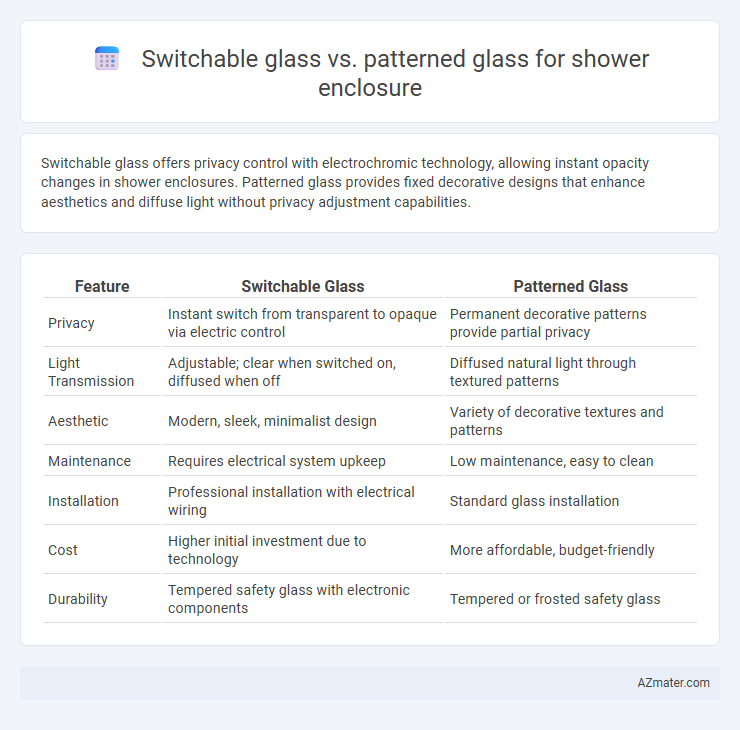Switchable glass offers privacy control with electrochromic technology, allowing instant opacity changes in shower enclosures. Patterned glass provides fixed decorative designs that enhance aesthetics and diffuse light without privacy adjustment capabilities.
Table of Comparison
| Feature | Switchable Glass | Patterned Glass |
|---|---|---|
| Privacy | Instant switch from transparent to opaque via electric control | Permanent decorative patterns provide partial privacy |
| Light Transmission | Adjustable; clear when switched on, diffused when off | Diffused natural light through textured patterns |
| Aesthetic | Modern, sleek, minimalist design | Variety of decorative textures and patterns |
| Maintenance | Requires electrical system upkeep | Low maintenance, easy to clean |
| Installation | Professional installation with electrical wiring | Standard glass installation |
| Cost | Higher initial investment due to technology | More affordable, budget-friendly |
| Durability | Tempered safety glass with electronic components | Tempered or frosted safety glass |
Introduction to Shower Enclosure Glass Options
Switchable glass offers privacy on demand by electronically toggling between transparent and opaque states, making it ideal for modern, customizable shower enclosures. Patterned glass features textured or etched designs that enhance privacy while adding a decorative element to the bathroom space. Both options provide durability and moisture resistance, but switchable glass delivers advanced technological control, whereas patterned glass emphasizes aesthetic appeal.
What is Switchable Glass?
Switchable glass for shower enclosures utilizes electrochromic technology to change from transparent to opaque at the flick of a switch, providing instant privacy and modern aesthetics. Unlike patterned glass, which features fixed textures or designs etched or embossed for decorative or privacy purposes, switchable glass offers dynamic control over light and privacy levels. This smart glass enhances functionality with versatility, ideal for customizable bathroom environments.
What is Patterned Glass?
Patterned glass for shower enclosures features textured surfaces created by rolling molten glass over patterned rollers, resulting in unique designs that enhance privacy while diffusing light. Unlike switchable glass, which uses electronic technology to change from opaque to transparent, patterned glass offers a permanent decorative option that requires no power source. Its durability, ease of maintenance, and wide range of patterns make it a popular choice for both aesthetic appeal and functionality in wet environments.
Privacy Features: Switchable vs Patterned Glass
Switchable glass offers instant privacy by electronically toggling from transparent to opaque, making it ideal for versatile shower enclosures where privacy needs may change. Patterned glass provides consistent privacy through textured designs that obscure visibility but do not change state, offering a permanent solution with aesthetic patterns. While patterned glass relies on static surface treatments to diffuse light and maintain privacy, switchable glass uses advanced liquid crystal technology to control light transmission dynamically.
Aesthetic Appeal and Design Flexibility
Switchable glass offers modern aesthetic appeal with its ability to change from clear to opaque, providing privacy without sacrificing light transmission, ideal for sleek, contemporary shower enclosures. Patterned glass provides a timeless decorative element through various textures and designs, enhancing privacy while adding a customizable artistic touch that complements traditional or eclectic bathroom styles. Both options deliver design flexibility, with switchable glass favoring minimalist elegance and patterned glass allowing for creative personalization through diverse patterns and finishes.
Maintenance and Cleaning Considerations
Switchable glass for shower enclosures requires specialized maintenance, involving gentle, non-abrasive cleaning agents to preserve its electrochromic properties, while patterned glass typically allows for easier cleaning due to its static texture and conventional glass composition. The smooth, interactive surface of switchable glass can be prone to damage from harsh chemicals or abrasive materials, necessitating careful attention to prevent clouding or functionality loss. Patterned glass, often self-concealing minor water spots or soap scum due to its texture, demands less frequent, straightforward cleaning efforts, making it more practical for users prioritizing low-maintenance options.
Durability and Longevity Comparison
Switchable glass for shower enclosures features an electrochromic layer that can transition between transparent and opaque states, but its durability depends on the electrical components and requires careful maintenance to avoid damage over time. Patterned glass, made from textured or embossed tempered glass, offers superior longevity with high resistance to scratches, impacts, and daily wear, making it a low-maintenance option for long-term use. In terms of durability, patterned glass generally outperforms switchable glass, ensuring sustained clarity and structural integrity in high-moisture bathroom environments.
Energy Efficiency and Light Control
Switchable glass offers superior light control by allowing instant transition from transparent to opaque, reducing the need for additional window treatments and enhancing privacy while optimizing natural light in the shower enclosure. Patterned glass diffuses light effectively but lacks the dynamic opacity adjustment, potentially leading to increased reliance on artificial lighting and less energy efficiency. The ability of switchable glass to modulate light transmission contributes to better thermal performance, minimizing heat loss and improving overall energy savings compared to static patterned glass.
Cost and Installation Considerations
Switchable glass for shower enclosures typically incurs higher costs due to advanced technology that enables privacy control through electric activation, while patterned glass offers a more budget-friendly option with etched or textured designs. Installation of switchable glass requires electrical wiring and specialized mounting to accommodate the electronic components, increasing labor time and complexity. Patterned glass installation is straightforward, resembling standard glass fitting without the need for electrical work, leading to lower overall installation expenses.
Which Glass Type is Best for Your Shower Enclosure?
Switchable glass offers privacy on demand by transforming from transparent to opaque with an electrical switch, making it ideal for modern, versatile shower enclosures. Patterned glass provides consistent privacy through textured designs while allowing light diffusion, perfect for traditional or decorative bathroom styles. Choosing the best glass depends on whether you prioritize dynamic privacy control or a permanent, stylish privacy solution in your shower enclosure.

Infographic: Switchable glass vs Patterned glass for Shower enclosure
 azmater.com
azmater.com